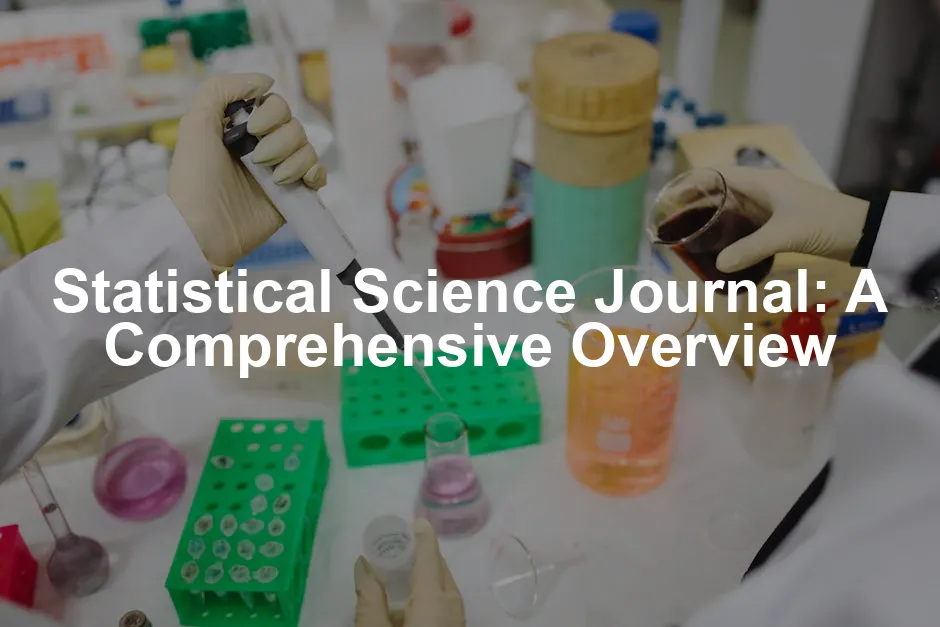Introduction
Statistical Science Journals are the rock stars of the statistics world. They are not just collections of papers; they are the lifeblood of statistical research. Imagine a place where the brightest minds gather to share insights, techniques, and breakthroughs. That’s exactly what a Statistical Science Journal does!
So, what exactly is a Statistical Science Journal? In simple terms, it’s a scholarly publication focusing on the field of statistics, probability, and their applications. These journals play a crucial role in advancing statistical research. They provide a platform for researchers to publish innovative findings, methodologies, and theoretical developments.
One of the key players in this arena is the Institute of Mathematical Statistics (IMS). Founded to foster the development and dissemination of statistical theory and applications, the IMS is the proud publisher of the Statistical Science Journal. This partnership ensures that the journal maintains high academic standards while remaining accessible to a broad audience.
In this article, we’ll take a closer look at the Statistical Science Journal, including its purpose, the significance of the IMS, and an overview of its content structure. You’ll learn about how this journal contributes to the field of statistics and why it matters to practitioners, researchers, and students alike. So grab your statistical toolbox, and let’s get started!

The Institute of Mathematical Statistics (IMS)
Overview of IMS
The Institute of Mathematical Statistics (IMS) is a prestigious organization established to promote the theory and application of statistics and probability. Founded in 1935, the IMS has been at the forefront of statistical research and education for decades. Its mission? To advance statistical knowledge and foster collaboration among statisticians and mathematicians.
IMS is not just a publisher; it’s a community. It connects researchers, educators, and practitioners in the field of statistics. Members benefit from resources like conferences, publications, and networking opportunities. This collaboration is crucial for pushing the boundaries of statistical science.
The IMS hosts various journals, including the Statistical Science Journal. This journal serves as a platform for sharing cutting-edge research and developments in the field. The importance of the IMS in the academic community cannot be overstated. It plays a critical role in shaping the future of statistical research and education.
Speaking of cutting-edge research, if you want to dive deeper into the world of statistics, grab a copy of “The Art of Statistics: Learning from Data” by David Spiegelhalter. It’s a fantastic read that takes you through the nuances of understanding data without making you feel like you’re stuck in a statistical nightmare.

Publications by IMS
The IMS is known for its high-quality publications. In addition to the Statistical Science Journal, it publishes several other renowned journals:
- Annals of Applied Probability: This journal focuses on applied probability, providing insights into real-world applications.
- Annals of Statistics: A leading journal that covers a wide array of statistical theories and methodologies.
- Annals of Applied Statistics: This journal emphasizes practical applications of statistical methods across various fields.
These publications are vital in the statistical community. They not only disseminate important research but also set the standard for academic rigor in the field. By publishing these journals, the IMS ensures that the latest advancements in statistics reach a global audience.

What is the Statistical Science Journal?
Mission and Objectives
The Statistical Science Journal serves a vital purpose. Its main goal is to showcase the richness and breadth of statistical thought. This journal highlights contemporary statistical ideas, all while keeping the technical level accessible. It’s like a cozy café for statistics enthusiasts, where practitioners, researchers, and students can gather to share insights.
Imagine a place where statistical concepts meet real-world application. The journal aims to bridge that gap by presenting innovative methodologies and research findings. Whether you’re a seasoned statistician or a curious student, this journal caters to your needs. It’s a treasure trove of knowledge, making statistical discourse engaging for everyone involved.
The journal not only presents groundbreaking research but also encourages discussions that reflect the unity of the field. Readers can find philosophical musings and alternative interpretations that spark curiosity. It’s a platform that welcomes diversity in thought, inviting contributions from various backgrounds in statistics and probability.
If you’re looking for a solid foundation in statistics, consider picking up “Naked Statistics: Stripping the Dread from the Data” by Charles Wheelan. It’s a witty and engaging guide that strips away the complexity and helps you understand the beauty of statistics.

Structure and Content
The Statistical Science Journal features a diverse array of articles. You’ll find peer-reviewed research papers, short communications, and even philosophical discussions. Each article aims to present contemporary statistical thought in an engaging, digestible format.
Peer-reviewed articles are the heart of the journal. They undergo rigorous evaluation, ensuring that only high-quality research makes it to publication. This process maintains the journal’s academic integrity and keeps readers informed of the latest advancements in the field.
Short communications are a new addition to the journal. These concise pieces, limited to 10 pages, provide insights into current research areas. They might include alternative proofs of established results or suggest new methodologies. This format encourages quick dissemination of ideas without the need for lengthy dissertations.
Accessibility is key for the Statistical Science Journal. The content is designed to be understood by a wide audience. Whether you’re a seasoned researcher or a student just starting, the journal ensures that everyone can engage with the material. Articles are presented in a manner that demystifies complex concepts, making statistics feel less intimidating.
Moreover, older articles become open access after a set period, increasing their availability. This policy allows even broader access to important research. It ensures that knowledge flows freely and supports the ongoing education of future statisticians.
In essence, the Statistical Science Journal combines rigorous research with an open-door policy for ideas. It serves as a platform for sharing knowledge, fostering community, and advancing the field of statistics. By doing so, it encourages a collaborative environment where everyone can contribute to the ever-evolving tapestry of statistical science.

Editorial Board and Review Process
Review Process
The peer-review process is a cornerstone of academic publishing. It ensures that only the highest quality research gets published. Submissions to the Statistical Science Journal undergo a meticulous evaluation by experts in the field. This process is not just a formality; it’s crucial for maintaining the journal’s reputation.
Once a manuscript is submitted, it’s first screened by the editorial team. If it passes this initial check, it gets sent to reviewers who provide constructive feedback. Reviewers assess the research’s originality, methodology, and relevance. Their insights help authors refine their work, enhancing its clarity and impact.
It’s fascinating to think about the journey a paper takes. From the moment an author hits “submit,” their research is scrutinized, discussed, and improved. This collaborative effort between authors and reviewers is vital. It not only elevates the quality of individual articles but also upholds the journal’s academic standards.
Rigorous peer review acts as a safety net for the academic community. It prevents the spread of misinformation and ensures that published research is reliable and credible. In a world inundated with information, having a trusted source is invaluable. The Statistical Science Journal exemplifies this commitment to quality through its thorough review process.

Recent Trends and Topics in Statistical Science
Current Issues and Research Areas
Statistical science is a dynamic field, constantly evolving to meet new challenges. Recent trends highlight significant advancements in statistical methods and their applications. The journal has published a range of innovative studies that reflect this growth.
One notable trend is the rise of Bayesian methods. These techniques have gained traction for their flexibility in dealing with uncertainty. For instance, researchers have applied Bayesian models to fields like healthcare and finance, providing robust solutions to complex problems. The journal features articles that showcase these applications, illustrating how Bayesian approaches can lead to better decision-making. If you want to explore Bayesian statistics further, check out “Bayesian Statistics the Fun Way” by Will Kurt – it’s a delightful way to learn!

Causal inference is another hot topic in statistical research. Understanding cause-and-effect relationships is crucial in various fields, from social sciences to epidemiology. Recent studies published in the journal have explored new methodologies for causal inference. These advancements help researchers draw more accurate conclusions from their data.
The evolution of statistical methods also includes the integration of machine learning techniques. The intersection of statistics and machine learning is producing exciting developments. For example, support vector machines and other algorithms are being utilized for predictive analytics. Articles in the journal delve into these methodologies, highlighting their practical implications.
Moreover, the journal emphasizes the importance of short communications. This new format allows researchers to share concise findings on emerging topics. These brief articles often cover alternative proofs, new methodologies, or interpretations of existing results. They offer readers quick insights into the latest innovations without the lengthy exposition typical of traditional articles.
The recent issues of the Statistical Science Journal reflect a commitment to addressing current issues in the field. By presenting cutting-edge research, the journal keeps its audience informed and engaged. Whether it’s exploring Bayesian methods or causal inference, the journal serves as a valuable resource for practitioners, researchers, and students alike.
As statistical science continues to advance, the Statistical Science Journal remains at the forefront. Its dedication to high-quality research ensures that it will continue to shed light on the exciting developments shaping the future of the field.

Impact Factor and Ranking
The Statistical Science Journal boasts an impressive impact factor, which is crucial in academic publishing. As of 2023, this journal has an impact factor of 3.9. This figure highlights its influence in the statistics field, showcasing the journal’s ability to attract citations. A high impact factor signifies that the articles published are not only numerous but also widely referenced by peers.
But what does this impact factor really mean? It’s a measure of the average number of citations to recent articles published in the journal. In simpler terms, a high impact factor indicates that the research published within these pages is considered valuable and relevant by the academic community.
When comparing the Statistical Science Journal with other statistics journals, it holds its ground firmly. For instance, it ranks #18 out of 123 in the Statistics and Probability category. This ranking places it in the upper echelons of academic journals, affirming its reputation. Notably, it maintains a Q1 quartile ranking for both Statistics and Probability, as well as Mathematics. This means it is among the top 25% of journals in these areas.
In summary, the high impact factor and top-tier ranking of the Statistical Science Journal make it a premier choice for researchers looking to publish impactful work. It stands tall among its peers, reflecting a commitment to advancing statistical science. Learn more about the significance of impact factors in statistical research.

Access and Subscription Information
Access Details
Accessing the Statistical Science Journal is a straightforward process, designed to accommodate a broad audience. Readers can access the journal through various means, ensuring that statistical knowledge is not locked behind barriers.
For those interested in subscription options, institutional subscriptions are available. These allow universities and organizations to provide access to their members. Institutional subscriptions often offer campus-wide access, making it easier for students and faculty to engage with the latest research.
Individual subscriptions are also an option for those who prefer personal access. However, institutional subscriptions typically provide more comprehensive access and can be more cost-effective, especially for larger groups.
In addition to subscription models, the journal publishes open access articles. This means that certain articles can be accessed freely by anyone, even without a subscription. Open access articles are typically those published after a specific period or as part of special issues. This approach enhances the journal’s reach, allowing vital statistical research to be shared widely.
The importance of these access options cannot be overstated. They facilitate the dissemination of knowledge, enabling researchers, practitioners, and students to stay informed about advancements in statistical science.
In conclusion, the Statistical Science Journal provides multiple access paths, catering to both institutional and individual needs. Its commitment to open access further enhances its role as a vital resource in the statistics community. Whether you’re part of an institution or a curious individual, there’s a way for you to engage with this leading journal.

Funding and Institutional Support
Funding Opportunities
Navigating the world of funding for statistical research can feel like trying to find a needle in a haystack. Luckily, there are numerous opportunities out there for researchers looking to secure grants and funding for their projects.
First things first, the Institute of Mathematical Statistics (IMS) is a fantastic resource. They provide guidance on finding funding and grants tailored specifically for statistical research. Their website is a treasure trove of information, showcasing various opportunities available to researchers at different stages of their careers.
The Institute of Mathematical Statistics (IMS) provides valuable resources for researchers seeking funding opportunities. Learn more about statistical research funding and support.

Another excellent avenue for funding is government and private foundations. Many organizations offer grants aimed at fostering innovative research in statistics. Websites like Grants.gov and Foundation Center can help researchers find suitable funding sources.
Don’t forget to check out academic institutions. Many universities offer internal grants that support faculty and graduate students working on statistical projects. Connecting with your institution’s research office can lead you to hidden gems.
Networking is also critical. Engaging with fellow statisticians and attending conferences can open doors to funding opportunities. Often, researchers share insights about grants they have successfully applied for, providing valuable tips for your own applications.
Lastly, consider collaborating with other disciplines. Interdisciplinary projects often attract more funding, as they address complex problems that require a multifaceted approach. Statistics plays a crucial role in various fields, so don’t hesitate to reach out to colleagues in other departments.
In summary, researchers have several pathways to explore when seeking funding for statistical research. The IMS, government foundations, academic institutions, networking, and interdisciplinary collaborations all play vital roles in supporting the next wave of statistical innovation.

Please let us know what you think about our content by leaving a comment down below!
Thank you for reading till here 🙂
All images from Pexels




